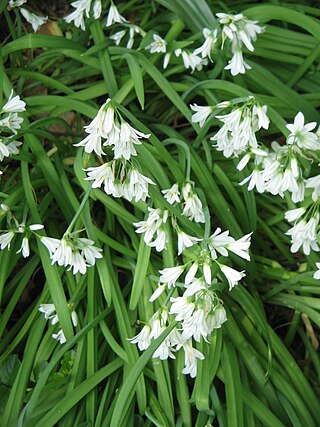Top Qs
Timeline
Chat
Perspective
Allium triquetrum
Species of flowering plant From Wikipedia, the free encyclopedia
Remove ads
Allium triquetrum is a bulbous flowering plant in the genus Allium native to the Mediterranean basin. It is known in English as three-cornered leek or three-cornered garlic, in Australia as angled onion,[4] and in New Zealand as onion weed.[5] Both the English name and the specific epithet triquetrum refer to the three-cornered shape of the flower stalks.[6]
Remove ads
Description
Allium triquetrum produces stems that are 17–60 cm (6+3⁄4–23+1⁄2 in) tall and concavely triangular in cross-section. During winter and spring, each stem produces an umbel inflorescence of 4–19 flowers.[7] The tepals are 10–18 mm (13⁄32–23⁄32 in) long and white, but with a "strong green line".[8] Each plant has two or three narrow, linear leaves, each growing up to 15 cm (6 in) long,[7] which have a strong onion smell when crushed.
Remove ads
Distribution and habitat
Allium triquetrum is native to southwestern Europe, northwestern Africa, Madeira, and the Canary Islands, where it grows in meadows, woodland clearings, on river banks, and roadside verges from sea level to an elevation of 850 metres (2,790 ft).[7] It has also been introduced to Great Britain, Ireland, Azores, New Zealand, Turkey, Australia, California, Oregon, and South America,[7][9] and is a declared noxious weed in some of those places.[10] It has been recorded as an alien at a garden waste site on Howth Head, Ireland.[11]
Remove ads
Culinary uses

All parts of the plant, from the bulb to the flowers, are edible fresh or cooked.[12] It can be used in dishes similarly to spring onions and wild onions, as it is similar both morphologically and in taste.[13]
References
External links
Wikiwand - on
Seamless Wikipedia browsing. On steroids.
Remove ads


